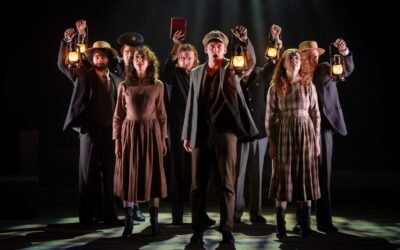By Chenoah Eljan
The Complete Works of William Shakespeare (Abridged) is exactly what it says on the packet: the Bard’s 38 plays condensed into an hour and half, roughly 152 costume changes, four dozen murders and a kiss. It would seem an impossible feat, and yet Travis Handcock, Peter Bevan and Craig Lenaine-Smith go from tragedy to comedy to tragedy again at such an impressive pace they even manage to do one play three times. The trio tackle their seemingly impossible feat with a commitment to silliness and fun that is less a parody of Shakespeare than a genuine understanding of his craft. This is barf jokes, innuendo, physical comedy and a rotating cast of terrible wigs that the Bard himself would have loved. There is an unexpected level of self-awareness that makes this play genuinely refreshing and surprisingly delightful at every turn.
Handcock, Bevan and Lenaine-Smith are all excellent and evenly matched, but diverse they are not. It is difficult to criticise the casting given their evident camaraderie and chemistry, however it seems a missed opportunity. For example, Handcock is hysterical as Juliet, Ophelia and nearly every other female character and yet one could imagine this running joke (“Fine, I’ll get a wig”) might have been even stronger had Hancock been delivering it to a female actor.
The timing is impressively impeccable, particularly for entrances and exits that give the play a sense of momentum and allow the actors to take the time needed so they are not speeding through the verbiage. One can easily image Handcock (who directs), whistle in mouth, stop-watch in hand, drilling the cast and crew on timing. And it pays off. What appears to be three guys mucking around on stage is so expertly crafted the audience is unaware of the machinations. Not that the audience has much time to think, every minute or two one of the actors bursts onto the stage in a new ridiculous ensemble (unless toy boat leis are all the rage on the runways of Paris these days) vibrating with energy and enthusiasm and a full thesaurus of facial expressions.
The actors break the fourth wall with such regularity that the audience is left with the constant discomfort that audience participation is imminent. Just as the collective fear has nearly dissipated in the second act, the house lights are up and the dreaded moment arrives. Except that it is not a moment, it is several inevitably protracted minutes, with guests brought on stage, the whole audience given lines, hand waving practiced. It is hard to imagine the payoff will be worth all the stuffing around. And it appears it was hard for the playwrights to imagine as well, because it is not. Fortunately, the house lights go back down, the actors get back on track and the audience breaths a collective sigh of relief that that part is over.
First and foremost this play is funny, and it knows it’s funny. But a niggling thought works its way into your brain as you watch it: you are actually learning. It’s a great refresher for those who haven’t touched a Shakespeare play since high school. One might even say (but certainly not to a high school English teacher) that it is a compelling and very funny alternative to the entire high school Shakespeare curriculum.
You don’t need to know Shakespeare’s plays, or like them, to enjoy this play. There is genuinely something for everyone: inside jokes for the bardolators, delightfully flamboyant (if, perhaps, at times potentially racially insensitive) costumes, dancing ghosts, three middle aged white guys rapping, a genuinely touching Hamlet monologue (no, not that one), and brief nudity.





